BUILDING YOUR BRAND WITH SOCIAL MEDIA
PRESS PLAY >> TO VIEW KEN MESSAGE FOR JANUARY.
This year’s annual National Retail Federation convention exhibited more energy and optimism from the attendees (over 27,000 of them) than I have seen over the past several years. The Expo was packed into three halls with high tech tools that would help just about any retail establishment operate more effectively. The sessions provided passion and excitement for the future and stressed the importance of retail to the global economy. And talk of social media and mobile marketing was everywhere you went. Indeed, it’s time to recognize that these cutting edge marketing tools have come of age and should be thought of as requisites for any sound branding and promotional plan for today’s retailers.
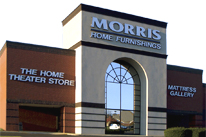 For example, take the case of Morris Home Furnishings from Dayton, Ohio. VP Marketing Robert Klaben provided some interesting examples of how his company was using social media to increase sales to the audience at the Main Street Session that was targeted to independent retailers. Kleben not only showed how Morris used Facebook (and other tools) to interact with their customers on an ongoing basis, but he showed how this has become one of the best measurement tools for evaluating the response to many of their promotions and loyalty building efforts. Sure, they were generating increased traffic and sales, but they have also been able to create loyalty that can be measured by the interactive responses and feedback that their customers are eagerly providing. These are not simply sales promotions, but brand building programs that are building relationships that will bring the customers back to their stores many times in the future. Granted the furniture business is not a frequent store visit experience, so you need to build an ongoing communication with your customers to be the first place they think about when the need for furniture arises. Their experiences show that the dialogue is building fast and the relationships are built on the heart not just the wallet.
For example, take the case of Morris Home Furnishings from Dayton, Ohio. VP Marketing Robert Klaben provided some interesting examples of how his company was using social media to increase sales to the audience at the Main Street Session that was targeted to independent retailers. Kleben not only showed how Morris used Facebook (and other tools) to interact with their customers on an ongoing basis, but he showed how this has become one of the best measurement tools for evaluating the response to many of their promotions and loyalty building efforts. Sure, they were generating increased traffic and sales, but they have also been able to create loyalty that can be measured by the interactive responses and feedback that their customers are eagerly providing. These are not simply sales promotions, but brand building programs that are building relationships that will bring the customers back to their stores many times in the future. Granted the furniture business is not a frequent store visit experience, so you need to build an ongoing communication with your customers to be the first place they think about when the need for furniture arises. Their experiences show that the dialogue is building fast and the relationships are built on the heart not just the wallet.
 It’s time for more retailers to take the same approach as Morris. It’s now expected that a retailer will have a robust website that will provide them not only a chance to get product information but also help them complete the transaction. This simply gets you into the ballpark. However, to build a strong brand relationship, social and mobile marketing can certainly accelerate the process. Remember, convenience is more important than ever and the online media help make it easier than ever before to shop and make an intelligent purchase without ever having to go to another mall. Facebook has gone far beyond being a place to share your personal experiences. It is the forum for letting retailers know what you like and how you want your purchase experience.
It’s time for more retailers to take the same approach as Morris. It’s now expected that a retailer will have a robust website that will provide them not only a chance to get product information but also help them complete the transaction. This simply gets you into the ballpark. However, to build a strong brand relationship, social and mobile marketing can certainly accelerate the process. Remember, convenience is more important than ever and the online media help make it easier than ever before to shop and make an intelligent purchase without ever having to go to another mall. Facebook has gone far beyond being a place to share your personal experiences. It is the forum for letting retailers know what you like and how you want your purchase experience.
Forums like shop.org’s annual conference and the CRMC in Chicago are growing each year because of the interest by retailers in learning more about how to use these media. And the conferences are loaded with great information about how to use them to not only increase your business but also improve your brand. It’s time to stop thinking of these as separate tactics and to include them in the strategy development for any successful marketing and branding plan.
LEADERSHIP—THE KEY TO A STRONG RETAIL BRAND
PRESS PLAY >>>NOW FOR KEN’S WELCOME MESSAGE
As the blitz of holiday advertising reaches a crescendo, it’s refreshing to see some retail marketers stick to the strong branding messages that has separated them from the rest of the pack. I’ve talked about Hallmark many times in the past when it comes to holiday advertising, but I was reminded about how strong their strategy is when I saw another great spot for Publix Supermarkets the other night (coincidentally on the Hallmark Channel). A great message, well executed that inspires and respects the viewer and customer.
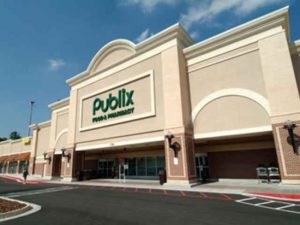 Shortly, after viewing the spot, I read the news that former Publix president and chief marketer had passed away in Lakeland, FL. In case you haven’t hear of Mark before, suffice it to say that he was more instrumental than anyone in making Publix a retail powerhouse in the southeast helping to build Publix sales from $3.2 Billion when he took over the top position to $27 Billion in just over 1000 stores in only five states. We won’t even talk about the dominant market share that Publix has built and the loyalty it has developed with its customers over the years. More significantly, however, is how Mark’s vision made Publix a brand that is part of the markets that its stores dominate. There are many factors that contribute to this strong position—well-run, well-merchandised stores in prime locations, loyal employees who love to work in a grocery store (although they don’t think of it in those terms), constant improvement in layout and design to really make “shopping a pleasure” (Publix’s long established slogan), and finally, to break-through creativity in their marketing that not only built a memorable brand, but also fought off the price competition so prevalent in this category of retail.
Shortly, after viewing the spot, I read the news that former Publix president and chief marketer had passed away in Lakeland, FL. In case you haven’t hear of Mark before, suffice it to say that he was more instrumental than anyone in making Publix a retail powerhouse in the southeast helping to build Publix sales from $3.2 Billion when he took over the top position to $27 Billion in just over 1000 stores in only five states. We won’t even talk about the dominant market share that Publix has built and the loyalty it has developed with its customers over the years. More significantly, however, is how Mark’s vision made Publix a brand that is part of the markets that its stores dominate. There are many factors that contribute to this strong position—well-run, well-merchandised stores in prime locations, loyal employees who love to work in a grocery store (although they don’t think of it in those terms), constant improvement in layout and design to really make “shopping a pleasure” (Publix’s long established slogan), and finally, to break-through creativity in their marketing that not only built a memorable brand, but also fought off the price competition so prevalent in this category of retail.
Publix brand products are not only consistent in package and quality, but they often outperform the national brands at a better price when it comes to brand quality. All this is a result of the leadership that Mark Hollis provided as marketing chief and then president. The standards were high, the creativity was encouraged and expected, the messages consistent with the company’s mission. Take a look at Publix’s most recent commercial (http://www.youtube.com/watch?v=wLJbYXRXtyU)
While Publix is as aggressive as anyone with strong, ongoing print promotions and a powerful BOGO strategy, it still reaches out to the customer every week of the year to maintain a brand that’s part of the lives of the customers it serves. That’s Mark Hollis’ legacy.
As we celebrate the holidays, I hope that your brand—whether it’s a store, a product, a service—or yourself—continues to build a relationship that endures.
Wishing you a Merry Christmas and Happy New Year!
Ken
RISK BEING DIFFERENT WITH YOUR BRAND!
As I sit here facing the Atlantic from a balcony of my condo at the Palmetto Dunes resort at Hilton Head Island, SC, it’s very apparent that the developers of this island and the resorts that occupy it had a unique vision when they started building some 50+ years ago. Having visited beach resort cities from Maine to Key West, I have always been disappointed how the developers and communities seem to think that tacky and overcrowding were the prerequisites for appealing to the tourists that support their economy. Hilton Head risked being different—to the point that if you drive down the main street of the town (HWY 278), you wouldn’t even know that there’s one of the east coast’s most beautiful beaches just a couple blocks or more away. No tall skyscraper condos or 3-star hotels, no neon signed surf shops, no strips of fast food or lousy food restaurants, no billboards. Sure there are businesses, but they have substituted taste and design in making this a pleasant drive despite the traffic. Just like other successful brands, Hilton Head sought to differentiate itself golf resort with beaches and tasteful homes for people who really want a relaxing beach vacation. Great restaurants are tucked away with the golf fairways and retail blends in with the many trees that shade an otherwise hot and sunny beach resort. This is a brand that works and the lodging and resort rates attest to its appeal—even in the off-season.
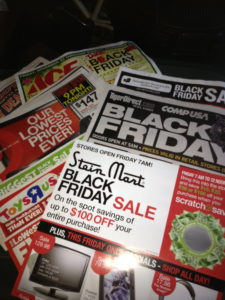 That brings me to Black Friday! Once again this year, retailers have abandoned any semblance of building a brand prior to the holidays in favor of the biggest sale of the year (or so they say). Even the name—formerly a trade description for the sales and profit potential of the day after Thanksgiving—is nothing more than a big clearance type of event. And it’s not just the retail stores. Black Friday is a good time to buy a car, clean your carpets, get your teeth whitened and just about any other business that is trying to get more customers at this time of year. Don’t have anything more to say about Black Friday? Just open the store even earlier…like Thanksgiving am or maybe even Wednesday pm. As a student of retail marketing, I admit that I went through every circular in the Thursday paper and didn’t find one that really stood out. Kohl’s and JCP outweighed the others but the messages were lost in the Black Friday shouting and screaming. Kind of like driving down the Grand Strand at Myrtle Beach or A1A in Daytona. Ycccch! The broadcast was equally boring, although Target dared to be different with some silly carolers that turned me off after the 6th time of seeing the spots (in one night). It’s time to give customers a reason to shop and then have a sale that means something other than a day of the week.
That brings me to Black Friday! Once again this year, retailers have abandoned any semblance of building a brand prior to the holidays in favor of the biggest sale of the year (or so they say). Even the name—formerly a trade description for the sales and profit potential of the day after Thanksgiving—is nothing more than a big clearance type of event. And it’s not just the retail stores. Black Friday is a good time to buy a car, clean your carpets, get your teeth whitened and just about any other business that is trying to get more customers at this time of year. Don’t have anything more to say about Black Friday? Just open the store even earlier…like Thanksgiving am or maybe even Wednesday pm. As a student of retail marketing, I admit that I went through every circular in the Thursday paper and didn’t find one that really stood out. Kohl’s and JCP outweighed the others but the messages were lost in the Black Friday shouting and screaming. Kind of like driving down the Grand Strand at Myrtle Beach or A1A in Daytona. Ycccch! The broadcast was equally boring, although Target dared to be different with some silly carolers that turned me off after the 6th time of seeing the spots (in one night). It’s time to give customers a reason to shop and then have a sale that means something other than a day of the week.
Finally, CBS News had interviews with the Ron Johnson of JCP and Bruce Nordstrom of my favorite department store this week. Essentially, they were asked if there is any hope for department stores in the retail marketplace. They cited the many names of stores like Wanamakers, Marshall Field and Dayton’s that have disappeared. I have to give credit to Johnson for sticking to his guns about the changes at JCP despite declining revenue, profits, and stock prices. I have to admit that their circular still is the most appealing of all in the paper and their store changes really do make sense. As both of the CEO’s said, the department stores have to give people a reason to come to their stores by way of experience rather than just price. Nordstrom has been doing that for years and now has the technology in the hands of its associates to enhance the experience even more. Johnson says there is not alternative but to succeed. It’s all risky, but as Randy Gage points out in his new book—Risky is the New Safe—taking the easy road of emulation and following the competition is not the way to build a successful business today.
BRANDING TRUMPS BAILOUT EVERYTIME!
The political campaigns are in full force and once again I’m disappointed by the lack of branding by both parties in trying to get their candidates elected or re-elected in. November. The incessant battering of the opponent, I believe, does nothing more than turn off the voter and hide the qualifications of the candidates to lead our country. But, I’ve said this before in these articles–four years ago to be exact–so I won’t belabor that point. Which brings us to the subject of car advertising. Huh?
The good news from Motown, my hometown, is that car sales for all U.S. brands is up. And the threat of once-strong corporations going out of business has subsided for the time being. Of course, our political candidates credit the government bailout for saving the companies (GM and Chrysler ) and the thousands of jobs (not to mention the survival of our entire middle class society ). No doubt the millions of dollars in “loans” helped resuscitate the two struggling companies, but I believe that their recovery has more to do with branding than financing. Let’s take look at Chrysler to see how branding and inspired leadership made the recovery possible.
Three years ago, Chrysler was all but given up for dead. With bankruptcy looming and sales and market share dwindling, it certainly wasn’t a good investment much less be the first choice of car shoppers. While the bailout by the government was critical, more important for the recovery was the merger with Fiat of Italy and the new CEO, Sergio Marchionne. He had led Fiat’s recovery and every time I see a little Fiat 500 on the road today, I think back to the 1960’s when the same model was more like a toy than an economy car. They were small, Spartan, and didn’t really work too well. And they disappeared from the American marketplace. Fiat recovered by adding in exciting brands like Ferrari, Maserati, and Alfa Romeo, the company is a European powerhouse today despite the economy over there.
The key to Chrysler, however, was the arrival of Marchionne as CEO. He set new standards, shook up the organization, formed a new leadership team reporting directly to him, and restored confidence to the work force at the company. More important, he revitalized the brands—focusing on the strengths of the Jeep, Minivans, and Dodge light trucks. Once the strategies became more focused and the people became motivated and confident, the company started to re-brand itself to the consumers. It’s “Imported from Detroit” set a new standard for the company—and its hometown. The super bowl spots of a couple years ago took a no nonsense approach. Brand advertising for its models was creative and on target. Most important, the cars lived up to a brand promise of style and quality as well as performance that comes with an Italian influence.
And it’s working. Sales are up in double digits. Income was up $900MM for the first half of this year even while paying off the $6 Billion in loans to the federal government (early). The launch of the new Dodge Dart (definitely not the same Dart that my parents owned in the early 60’s) looks promising with exciting touches from their new Italian relatives. The brand is creating believers in the company, and by doing so is on the way to recovery. Marchionne says part of his plan was to move out of the Chairman’s Ivory Tower offices in Auburn Hills and down on the floor with the people building the cars and the brand. His influence is working and the brand is alive and exciting again.
“EXTREMISM IN THE PURSUIT OF A BRAND IS A VICE”
A couple months ago, I wrote an article supporting JC Penney’s new brand strategy and creative execution, indicating that it was the right thing to do to get the store back on track and differentiate itself in the marketplace. With the dismal performance in revenue and profits, the declining stock price, and the exit of some key top executives, many of you have questioned my wisdom and have asked me “What now?” for the beleaguered retailer.
 With the political campaigns at full speed, I’m reminded of a famous quote from the 1964 Republican candidate
With the political campaigns at full speed, I’m reminded of a famous quote from the 1964 Republican candidate  Barry Goldwater who defended his views when he said “Extremism in the pursuit of liberty is no vice.” Although I couldn’t vote then, I do remember that the voters rejected his extreme right views and with the exception of Goldwater’s home state and the Deep South, he was soundly rejected in favor of Lyndon Johnson. The pendulum would swing too far right and they would not accept that much change.
Barry Goldwater who defended his views when he said “Extremism in the pursuit of liberty is no vice.” Although I couldn’t vote then, I do remember that the voters rejected his extreme right views and with the exception of Goldwater’s home state and the Deep South, he was soundly rejected in favor of Lyndon Johnson. The pendulum would swing too far right and they would not accept that much change.
Retailers face the same challenge when they go through a re-branding process and eliminate every way they promoted in the past to go for the new strategy. Food retailers have done this when they have decided to give up on weekly ad and in-store specials and coupons for EDLP only to discover that the customers still want those specials in the store with the signs telling them how much they are saving. Since POP promotions generate over 80% of the sales, it’s no wonder that the average market basket goes down quickly and the customer doesn’t think she is getting the best prices. EDLP does work, but the stores need to keep some promotional excitement at the store and in their ads.
I still believe that going to an everyday pricing strategy works. After all, look at Wal-Mart and the success they have had. However, even the world’s largest retailer still runs a monthly circular to feature those low prices on the most wanted items at that time of year. Their in-store price reductions have long generated sales and a stronger low price position with their customers, and they continue to do that successfully with their shopping list comparisons for food today.
JCP should have made a strong, logical pitch to its customers about a new everyday pricing strategy supported by an edited down version of their aggressive print sales circulars and mailers. However, the confusing sometimes lower prices and sometimes clearance events coupled with less in-store signing excitement seems to have convinced their loyal customers (and some of those Kohl’s shoppers) that their specials weren’t as good as before. With the aggressive media campaign and break-through creative, they reached a lot of customers with that message.
I still think JCP’s new print creative is outstanding, their broadcast cuts through the clutter, and their stores are better merchandised. However, they went to extremes by downplaying their price points graphically and not defending themselves against Kohl’s and Macy’s who increased their aggressive sales promotion. The solution? Michael Francis, JCP’s deposed President who came from Target, should have stuck with what worked at his former store. Great creative, excellent everyday pricing, and aggressive and well-presented print promotions. Going to extremes didn’t work in 1964 and didn’t work in the malls of 2012
UPDATE 8/8–AL RIES JUST WROTE A GREAT ARTICLE ON THE SUBJECT IN AD AGE ON JCP. CHECK IT OUT AT http://adage.com/article/al-ries/al-ries-prescription-fix-jc-penney-retail-reinvention/236564/?utm_source=cmo_strategy&utm_medium=newsletter&utm_campaign=adage
KEN BANKS AND ROBYN WINTERS FEATURED IN SPEAK MORE, A NEW BOOK PUBLISHED BY THE NATIONAL SPEAKERS ASSOCIATION
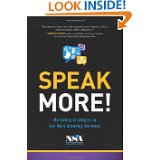 Ken Banks and Robyn Winters (co-authors of BrainBranding-Activate the Brain, Stimulate the Brand) are contributing authors to the new professional speakers reference book, Speak More, recently published by the National Speakers Association. It’s available on Amazon/Kindle and features marketing tips from 33 of NSA best speaker marketers. Here’s the description from Amazon. BrainBranding reaches out!
Ken Banks and Robyn Winters (co-authors of BrainBranding-Activate the Brain, Stimulate the Brand) are contributing authors to the new professional speakers reference book, Speak More, recently published by the National Speakers Association. It’s available on Amazon/Kindle and features marketing tips from 33 of NSA best speaker marketers. Here’s the description from Amazon. BrainBranding reaches out!
SPEAK MORE! PROVIDES CUTTING-EDGE, ROAD-TESTED, AND COMMONSENSE MARKETING STRATEGIES TO HELP PROFESSIONAL SPEAKERS ACHIEVE THEIR BUSINESS OBJECTIVES. Thirty-three members of the National Speakers Association (NSA), including renowned business experts, authors, and marketing gurus, share their sage advice for setting yourself apart from the competition. Whether you peruse the table of contents to find topics that pique your interest or read the book from cover to cover, you’ll discover real-life experiences describing what works and what doesn’t to effectively promote your business, brand, products, and services, and to grow your bottom line. LEARN FROM THE BEST AS YOU READ HOW TO: • Develop a strong personal brand • Get the most out of networking and public relations e orts • Publish a book to propel you from a speaker to an expert • Achieve a professional appearance to enhance your brand • Harness the power of social media • Create a do-it-yourself video • Launch your own radio show • Turn cold calls into hot new prospects • Snag and prepare for media interviews in your field • Optimize mobile marketing with QR codes • Go global with your message • And much more! Speak More! is tailored for keynote speakers, consultants, coaches, trainers, authors, and anyone seeking to expand the reach of their message. Many of the proven methods require little or no monetary investment, yet they provide big payoffs, including increased revenues and opportunities to speak more!
To order on Amazon, just Click HERE
STRONG BRANDS MATURE QUICKLY
I’m writing this month’s article from Prague, Czech Republic, shortly after returning from a walking tour of this vibrant city on a beautiful Sunday afternoon. It’s a wonderful day and the citizens (and tourists like us) enjoyed all that the city has to offer. With so much history and beauty, it’s hard to believe the Czech Republic is less than 20 years old as a country. After all the years of Communist oppression and turmoil, the country has emerged with it’s own personality and attitude that is not unlike many of the new brands that have established themselves in the marketplace in the past few years.
We tend to think that building a brand relationship is a long-term process that takes years of marketing and research to reach the top of the consumers’ preferences. Yet, it really is simply a matter of doing the right things first to determine where your brand’s niche is and how you can differentiate yourself from the competition in order to generate sales. Granted there are those “Hall of Fame” brands like Coca Cola, McDonalds, IBM, etc. that continually renew themselves and maintain their preference with the customer. However, there are plenty of new brands on the block like Zappos, Android, Whole Foods, Smart Car, LG, and Under Armor that have created powerful brands by following the steps necessary to define their brands before they ever started marketing them.
It all starts with having a Vision for your brand and determining what is going to differentiate you from the others in the same market. Not simply providing a new name or a new version of an existing brand, but creating one that meets a customer need and providing the value that will warrant their trial—quickly.
Next, you have to do the research necessary to quantify where your potential will be and who the competition is. A SWOT analysis is helpful, but it’s important to evaluate the market potential, the customer attitudes and perceptions, and the competitive perceptions before you move forward.
Taking these first couple steps with a sense of urgency can establish a brand quickly or (as in the case of Prague and it’s homeland) re-inventing a brand by building on its strengths and addressing its weakness before moving forward. An effective marketing and communications plan is a lot easier to develop once you take the time to make sure your brand is relevant and interesting.
COMING SOON: BRAIN BRANDING. THE MANUAL.
An easy to follow guide to building a brand that resonates with your customers.
BRANDING MAKE FOR GREAT ART & COPY
Whenever I talk with marketers and ad agencies, the conversation inevitably gets to whether breakthrough creative or a sound brand strategy is more important to the success of a product or service. Of course, I always answer “Both!”. What’s really important is the order in which these two challenges are addressed. So often, marketers (especially retailers) are so pressured to produce some immediate results that they rush to get out a new campaign or spot and make some noise that will result in more sales. Now, if the brand strategy that’s in place is already working and well developed, getting new creative may just be the answer. However, usually the fact that what’s currently reaching your customers isn’t working well is the result of poor branding in the first place.
This seems obvious to me and I believe that the really creative advertising gurus also agree that the brand comes first and then the creative. I recently received a DVD in the mail from a good friend, Cedar Hames, who is CEO and founder of a local agency here in St. Petersburg. To celebrate the 10th anniversary of Paradise Advertising, Cedar sent a complimentary copy of a PBS documentary from a couple years ago, title “Art & Copy”. The show featured interviews with some of the true great creative minds in the advertising business talking about their craft and some of the outstanding work that is legend in our business. The group included Mary Wells, the late Hal Riney, George Lois, Dan Wieden, Lee Clow, and others. To learn more about the program, go to http://www.pbs.org/independentlens/art-and-copy/film.html and I’m sure you can download or get a copy of the 90 minute program.
I won’t go into the details of each person’s comments on the program here, but it became obvious to me that they are/were all risk takers who dared to breakthrough with great spots like VW’s Think Small, Apple’s 1984, or Braniff Airlines’ Flying Colors. However, to the person they spoke highly of their clients and the direction they received from them. This was manifested in a brand strategy that reflected a thorough understanding of the market, the customer, and the competition. Developing a successful brand strategy is part of the process and opens the door for art and copy that truly breaks through and resonates with the four buying styles we talk about in our book (co-authored with Robyn Winters): BrainBranding—Activate the Brain, Stimulate Your Brand.
With so much mediocre advertising out there today (a great deal of which is from top companies and major brands), it would be beneficial for many of the marketers responsible to sit down and listen to what these “icons of creativity” had to say. It will make for great advertising and, more importantly, for successful brands.
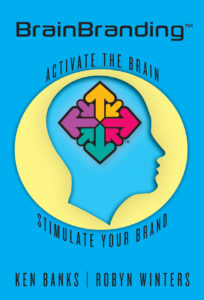
“COMING SOON: BrainBranding, The Manual. Read the book, then use this workbook to develop a brand strategy that works for all four buying styles.
JCP SPELLS A BRAND NEW BRAND!
If you have been reading these articles over the past couple years, you know that I have often questioned the strategies of stores like JCPenney and Kohl’s since it seemed that they must have had investments in a printing company or paper mills with the amount of print advertising that they have been pouring out. Moreover, it was hard to tell one sale ad from another and to understand if these sales circulars and the strategy behind them really broke through to the customers and motivated them into the stores. Differentiation certainly was not one of the objectives in my opinion.
That’s why I was really interested when JCPenney made some significant moves in marketing in 2011. In addition to Ron Johnson taking over at CEO and bringing his Target and Apple heritage with him, Michael Francis also made the move from Minneapolis to Plano as President. The results, I think have been noteworthy. I’ve always felt that Penney’s did a great job with running stores with exceptional displays and merchandising and their aggressive broadcast advertising under Mike Boylston was some of the best in the industry. However, they seemed to be obsessed with trying to out-promote their similar competition. How often can you have “lowest prices of the season” or a “one-two-three day sale” before the customer gets bored and ignores you. Certainly, Kohl’s continues to follow this promotional format, but their brand has been carefully developed with a new and younger shopper who has rejected JCPenney as “their mother’s store.” It was time to break that mold, and I think they are shaking it up with a good, sound creative strategy. The Ellen DeGeneres campaign not only broke through with humor and universally liked spokesperson but it also made a logical and sensible argument that has made WalMart the largest retailer in the world—no nonsense, every day low prices. The other broadcast spots have complemented Ellen’s message and have added some real creativity to what has been a retail wasteland in broadcast. The stores have been upgraded and the merchandise is better than ever.
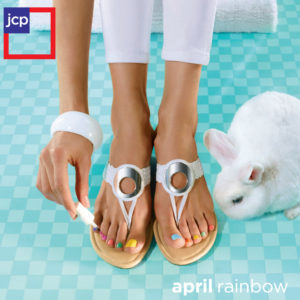 However, I think it’s the print advertising that stands out more than anything else for the jcp brand. It’s not simply Target advertising with a new logo. There are strong messages to go along with outstanding layout and photography. Simple yet striking. The ads make you want to read on and moreover, take a trip to see the stuff in the store. Yes, they still promote special prices on the first and third Friday (who’s going to remember that?) but in the atmosphere of these striking ad messages, even that seems to make sense. A recent article in the New York Times discussed the fact that most customers really liked and used coupons. Yes, we do (especially for pizza!). But the success of the largest retailer shows that a believable low price strategy can trump the one week specials over and over again.
However, I think it’s the print advertising that stands out more than anything else for the jcp brand. It’s not simply Target advertising with a new logo. There are strong messages to go along with outstanding layout and photography. Simple yet striking. The ads make you want to read on and moreover, take a trip to see the stuff in the store. Yes, they still promote special prices on the first and third Friday (who’s going to remember that?) but in the atmosphere of these striking ad messages, even that seems to make sense. A recent article in the New York Times discussed the fact that most customers really liked and used coupons. Yes, we do (especially for pizza!). But the success of the largest retailer shows that a believable low price strategy can trump the one week specials over and over again.
Finally, what about the name change? They had to communicate that things have changed and while the jcp logo is simple and contemporary, I think it sends a message of new and young, while maintaining the identity of the parent that has a long heritage in fashion and home. It will be interesting to watch what happens now since it will likely take the customers a while to come back and give jcp a try, but with the sound brand strategy in place and the creativity that’s already been shown, there’s a great chance for success.
THE VERY BEST IN BRANDING. HALLMARK KEEPS DOING IT
Once again I watched a Hallmark Hall of Fame original movie the other night and was impressed as always by the quality of the commercials that ran throughout the show. Some of these have been running for a few years (at least) and yet they still make the point and re-emphasize Hallmark’s position as the best brand in greeting cards and gifts year after year. The company understands its customers and understands the motivation behind sending a greeting for a special occasion.
However, what is impressive is the way Hallmark has aggressively solidified its position by changing with the times with creative use of the media. The Hallmark channel is one of the best vehicles for getting out the Hallmark message without seeming like your simply watching another commercial. The programming over the holiday’s is sheer genius as the non-stop holiday movies (some new, some repeats) that all seem to have the same message, but somehow manage to get you in the spirit of the season and provide an alternative to the reality shows and pre-event music awards concerts that fill the airwaves in between college and pro football games. The Hall of Fame specials continue to provide the best quality programs year after year without overdoing it and provide an excellent environment for the branding message that Hallmark consistently maintains every year. Add to this, Hallmark’s online subscriptions for e-cards which gives us the opportunity to send “the very best” online easily and economically. No doubt the internet and social networking has made a huge dent in the conventional greeting card business, but Hallmark has filled the void and gives you the opportunity to personalize while maintaining the Hallmark brand assurance.
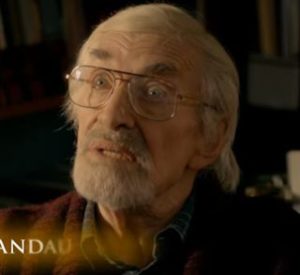 This brings me to another brand message at this time of year. This month’s Hall of Fame movie was “Have a Little Faith” based on Mitch Albom’s latest book of the same name. I’m a big fan of Albom’s books and this one was particularly poignant.
This brings me to another brand message at this time of year. This month’s Hall of Fame movie was “Have a Little Faith” based on Mitch Albom’s latest book of the same name. I’m a big fan of Albom’s books and this one was particularly poignant.
It’s the story of his encounter with two clergymen—his rabbi from his youth and an African-American minister in a broken-down Detroit slum church. I was particularly moved by the wisdom shared by Albert Lewis, Albom’s New Jersey rabbi, who asked him to write his eulogy and then spent 8 years sharing that wisdom with Mitch. In one conversation, Rabbi Lewis tells Mitch that one of life’s great challenges is to answer the question: “What is your glory?” In other words, what have you done to make the world a better place. It’s from this question, that Albom’s faith and commitment is awakened and drives him to help the Detroit church as well as his family and community. I’ve often asked my branding audiences and college classes to think about “What their brand’s are famous for?” in their quest to make their brand’s (product or personal) more successful. However, it struck me as I watched the movie that it’s the “glory” of our brand that makes it successful and enables it to stand out from the competition while building a relationship with your customers.
At this time of year, when we hear the word “glory” in many of the carols of the season. I hope that you consider what you can do to make a difference in the world as well through your personal and corporate brands. Like the companies (i.e. Hallmark) that stand out year after year during the holidays without relying on just another sale, you, too, can find the glory of the real meaning of this season.
Merry Christmas.
Ken
